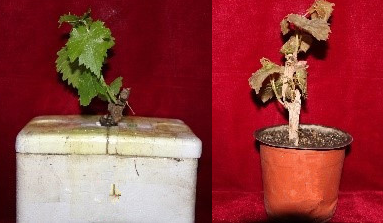

根区缓冲降温处理对葡萄叶片冻害的影响
# 共同第一作者
收稿日期: 2016-04-27
录用日期: 2016-05-23
网络出版日期: 2017-05-27
基金资助
国家现代葡萄产业技术体系建设专项(No.CARS-30)与长江学者和创新团队发展计划(No.IRT15R42)
Effects of Buffered Cooling in Root Zone on Frost Injury in Grape Leaf
# Co-first authors
Received date: 2016-04-27
Accepted date: 2016-05-23
Online published: 2017-05-27
为探索根区降温条件对葡萄(Vitis vinifera)叶片冻害的影响, 以1年生美乐葡萄(V. vinifera cv. ‘Merlot’)幼苗为试材, 设置根区正常降温和缓冲降温2种降温条件, 人工模拟霜冻, 分析了叶片冻害指数和叶片的荧光参数。结果表明, 根区正常降温会导致根系受冻, 同时叶片发生严重的冻害, 冻害指数达74.36%; 根区缓冲降温使根区温度保持在0°C以上, 叶片冻害指数降低53.29%, 仅有21.07%的叶片遭受了冻害。根区缓冲降温处理能有效提高叶片霜冻恢复过程中光化学淬灭系数(qP)和天线色素转化效率(Fvʹ/Fmʹ), 加快PSII光合电子传递量子效率(ΦPSII)的恢复, 提高热耗散能力(NPQ), 减轻霜冻后的光抑制(Fv/Fm), 有利于叶片霜冻后的恢复。

孙鲁龙 , 耿庆伟 , 邢浩 , 杜远鹏 , 翟衡 . 根区缓冲降温处理对葡萄叶片冻害的影响[J]. 植物学报, 2017 , 52(3) : 290 -296 . DOI: 10.11983/CBB16097
To study the effects of cooling conditions in the root zone on frost injury in grapevine leaves, we used 1-year-old Merlot grapevine (Vitis vinifera) seedlings. The root zone was cooled regularly or buffered. All seedlings were treated in the simulated frost condition, then the frost index in leaves was calculated, and the chlorophyll fluorescence parameters were analyzed to reflect the change of PSII activity. Root temperature cooled regularly conferred severe frost damage in leaves, with a frost index of 74.36%. Buffered cooling alleviated frost injury to 53.29%, with a frost index of only 21.07%. Buffered cooling in the root zone improved qP and Fvʹ/Fmʹ in leaves during the recovery period, sped up the recovery of photochemical activity in PSII (ΦPSII), improved the ability of heat dissipation (NPQ), and relieved photo- inhibition. Buffered cooling in the root zone was conducive for leaves to recover after frost.

| [1] | 郭连旺, 沈允钢 (1996). 高等植物光合机构避免强光破坏的保护机制. 植物生理学通讯 32, 1-8. |
| [2] | 胡文海, 肖宜安, 龙婉婉 (2005). 夜间低温后日间光照对海桐和榕树叶片的光抑制以及光系统II功能的影响. 植物生理学通讯 441, 467-470. |
| [3] | 刘俊, 刘崇怀 (2006). 龙眼葡萄棚架栽培条件下的根系分布. 果树学报 23, 379-383. |
| [4] | 毛娟, 陈佰鸿, 曹建东, 王利军, 王海, 王延秀 (2013). 不同滴灌方式对荒漠区‘赤霞珠’葡萄根系分布的影响. 应用生态学报 24, 3084-3090. |
| [5] | 孙鲁龙, 宋伟, 杜远鹏, 翟衡 (2015). 简易覆盖对泰安地区酿酒葡萄园冬季土壤温湿度的影响. 中外葡萄与葡萄酒 4, 12-16. |
| [6] | Bertamini M, Muthuchelian K, Rubinigg M, Zorer R, Velasco R, Nedunchezhian N (2006). Low-night temperature increased the photo-inhibition of photosynthesis in grapevine (Vitis vinifera L. cv. Riesling) leaves. Environ Exp Bot 57, 25-31. |
| [7] | Demmig-Adams B, Adams III WW, Barker DH (1996). Using chlorophyll fluorescence to assess the fraction of absorbed light allocated to thermal dissipation of excess excitation.Physiol Plant 98, 253-264. |
| [8] | Feng YL, Cao KF, Feng ZL (2002). Thermal dissipation, leaf rolling and inactivation of PSII reaction centers in Amomum villosum in diurnal course. J Tropic Ecol 18, 865-876. |
| [9] | Heber U, Bukhov NG, Shuvalov VA, Kobayashi Y, Lange OL (2001). Protection of the photosynthetic apparatus against damage by excessive illumination in homoiohydric leaves and poikilohydric mosses and lichens.J Exp Bot 52, 1999-2006. |
| [10] | Huang LK, Wong SC, Terashima I, Zhang X, Lin DX, Osmond CB (1989). Chilling injury in mature leaves of rice. I. Varietal differences in the effects of chilling on canopy photosynthesis under simulated ‘dry cold dew wind’ conditions experienced in south-east China.Aust J Plant Physiol 16, 321-337. |
| [11] | Johnson GN, Young AJ, Scholes JD (1993). The dissipation of excess excitation energy in British plant species.Plant Cell Environ 16, 673-679. |
| [12] | Mauro S, Dainese P, Lannoye R, Bassi R (1997). Cold- resistant and cold-sensitive maize lines differ in the phosphorylation of the photosystem II subunit, CP29. Plant Physiol 115, 171-180. |
| [13] | Maxwell K, Johnson GN (2000). Chlorophyll fluorescence—a practical guide.J Exp Bot 51, 659-668. |
| [14] | Molitor D, Caffarra A, Sinigoj P (2014). Late frost damage risk for viticulture under future climate conditions: a case study for the Luxembourgish winegrowing region.Aust J Grape Wine Res 20, 160-168. |
| [15] | Nikiforou C, Nikolopoulos D, Manetas Y (2011). The winter-red-leaf syndrome in Pistacia lentiscus: evidence that the anthocyanic phenotype suffers from nitrogen deficiency, low carboxylation efficiency and high risk of photo- inhibition. J Plant Physiol 168, 2184-2187. |
| [16] | Sonya L (2014). Frost: Canberra sees the silver lining in damaging frosts.Wine Viticult J 29, 48. |
| [17] | Sugiura T, Sumida H, Yokoyama S (2012). Overview of recent effects of global warming on agricultural production in Japan.Jpn Agr Res Q 46, 7-13. |
| [18] | Velikova V, Pinelli P, Loreto F (2005). Consequences of inhibition of isoprene synthesis in Phragmites australis leaves exposed to elevated temperatures. Agr Ecosyst Environ 106, 209-217. |
| [19] | Zhou Y, Huang L, Zhang Y, Shi K, Yu J, Nogués S (2007). Chill-induced decrease in capacity of RuBP carboxylation and associated H2O2 accumulation in cucumber leaves are alleviated by grafting onto figleaf gourd.Ann Bot 100, 839-848. |
/
| 〈 |
|
〉 |